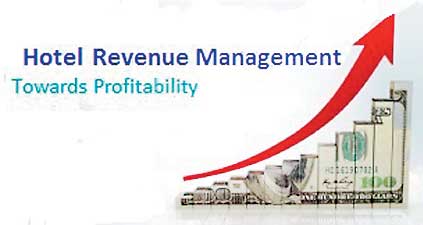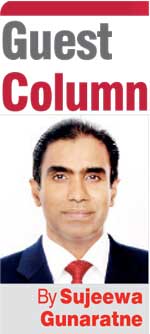Monday Nov 24, 2025
Monday Nov 24, 2025
Friday, 9 October 2015 00:00 - - {{hitsCtrl.values.hits}}
With the development of peace in the country, the number of tourist arrivals in Sri Lanka is on a rapid increase in country where some hotels enjoy profits while others run losses. 
Most hotels slashing prices are running at losses due to a lack of accurate market information. Many star class hotels get filled in advance through slashing room rates but miss opportunities to sell at a higher rate later, especially during high season. Also during the low season, hotels miss business opportunities by quoting higher room rates when similar standard hotels sell rooms at lower rates.
The only solution for these loss making hotels is ‘revenue management’, which directly enables revenue optimisation. In Sri Lanka, very few star class hotels practice revenue management. I hope this article will enlighten hoteliers who are keen to know about this business tool.
Hotel revenue management 
Airlines miss out on revenue if seats are not filled. Similarly, hotels can be at a loss if heads are not in beds, leaving rooms unoccupied. As a result, the hospitality industry is increasingly using new revenue management techniques to achieve better results by introducing innovative pricing strategies.
Hotel revenue management is about making the right room available for the right guest at the right price at the right time via the right distribution channel.
The fundamental focus of any business is to obtain profits. In this process, revenue management concepts have become popular methods in the business world. Revenue management is a combination of market research, competitor benchmarking and customer relationship management that categorises customers into price bands based on various services to optimise revenue. It is the science of optimising profits through market demand by forecasting and maximising rates and availability. If applied correctly, hotels should be able to expand their market size and increase revenues. Today’s complex multi-channel distribution landscape requires hotels to match the needs of diverse customer segments with a fixed supply of rooms, thereby driving the increased adoption of advanced revenue management technology.
Market segmentation in the hotel industry
Market segmentation is a crucial element in hotel revenue management. It allows you to target and market to a variety of consumer groups with different behaviours through offers that match their needs and budget levels. Market segmentation in the hotel industry begins with the identification of the purpose of the trip: whether it is for business or leisure. The price does not decide the market segmentation. Clear distinction must also be achieved between individual and group business. The market segmentation will help to identify the trends of the business: length of stay, day of weeks’ stays, total revenue per room, total revenue per client, booking lead time, cancellation %, no show ratio etc.
Here is an example of hotel market segmentation: Public: BAR Website, BAR Direct, BAR Indirect Commissionable and BAR Indirect Net. Promotions: Opaque; hidden hotel discount programs, Flash Sales; promotional website offering membership discounts, Mobile; mobile websites offering same day or last minute discounts, Online Campaigns; internet publication offers and packages, Offline campaigns; print publication offers and packages, Special Events; packages and offers during holidays, festivals and concerts. Negotiated Rates: Corporate Dynamic Rates, Corporate Flat Rates(Government or Crew). Groups: Leisure, Business, Conference / Banquet, Incentive, Wedding, Events. Wholesale: FIT, Tour Operators and Wholesalers. Other: Complimentary, Barter, Walk-In, Overflow (from another hotel), House Use and Time Share.
The above segmentation is a general guideline. Each hotel has to decide what segmentation best fits their market and property.
Building revenue management culture in organisations is the primary and most important part of this process. Revenue management is becoming more complex, but at the same time more rewarding. Revenue management in some shape or form plays a role in many strategies and tactics deployed in most companies in the modern business world. The relationship between the teams within an organisation that set the strategies and the teams that deploy the tactics are extremely important. Without a defined link, strategies and tactics may conflict, leading to neither being successful. Many hotels have seen double-digit revenue improvement by employing revenue management techniques. This is especially true with the GM’s support. By staying proactive about revenue management within their hotels, GMs can help their teams drive toward top-of-the-line revenues for the hotel and stand out as true revenue drivers within their organisations.
Setting Revenue Management goals and objectives
The proper goal of a revenue management program is not to increase average room rates, neither is it to increase average occupancy rates. Revenue management programs must focus on optimising revenue through right pricing strategies.
Forecasting demand, optimising demand, controlling demand and monitoring demand are the four main components that form the revenue management cycle.
Forecasting demand and occupancy: Good demand forecasting is a key aspect of revenue management. Improvements in the demand forecasts used as inputs to the inventory allocation process translate directly into increased revenue in the form of higher average rates per customer and better utilisation of the demand without losing a reservation that should have been accepted.
Optimising demand: Once the analysts have a forecast, analysts can determine on which days it is likely that analysts will have to turn down or up demand to decide the right price for rooms.
Controlling demand: Historically analysts may be able to determine that the demand accepted has only really been controlled by the capacity of the hotel, that is, reservations have only been denied when a night was full. Alternatively, analyst may know that in some cases, length-of-stay and rate controls were put in place to control the amount and type of demand that analysts accepted.
Monitoring demand: This stage of the process is when analysts look at what is happening and compare it to what analysts expected to happen based on your forecasts.
Choosing an automated revenue management solution
Hotels can achieve a greater market share by using an intelligent Revenue Management system that bases room rates on real-time changes in the marketplace. Managing prices by demand allow hotels to fill rooms that would otherwise remain empty. Through dynamic pricing, model hotels can gain a competitive advantage by basing rates on a calculation of occupancy, competitors and season.
Star class hotels have to adopt technological advancements in order to optimise revenue. Revenue Management system enable hotels to process all the booking data more systematically, effectively and efficiently. These systems use mathematical calculations to forecast guests and revenue demand at different times. The systems perform micro analysis to give high accuracy outputs and eliminate human errors and inefficiencies.
Selecting the right distribution channels
There have been many changes in technology over the last few decades within the revenue management field. In the past, guests chose a hotel by looking for the glowing vacancy sign in the window. Now, guests spend hours on their iPod looking for the best deal. As we move into the digital revolution, we must constantly update and monitor our online distribution channel strategies. Online Travel Agencies (OTAs) are a blessing and a curse for hotels. They’re a blessing because they give additional exposure to potential customers, but a curse due to high commission rates. As with any business, it’s a good idea to diversify channels. To become too reliant on a few channels and not direct bookings, hotels could become a slave to those few revenue generating channels. Many hotels find themselves in this situation with OTA’s, and it becomes obvious that the hotel is not making as much money as they should be with every OTA booking. Most guests will now check guest reviews, compare pricing and find exactly what they are looking for. Management should evaluate performance of distribution partners and contracted rates (OTA, FIT, tour operator, corporate, consortia, crew, groups, etc.), which will help manage the operation.
Choosing ‘best fit’ technology: Deciding the right price for rooms at different times, known as ‘Dynamic Pricing’, is amongst the biggest challenges for hotel management. Maintaining the right Revenue Management practice will help hotel management to optimise revenue from its inventories. Experienced and knowledgeable Managers in Revenue Management field could help hotels to achieve this task. By deploying automated revenue management tools could keep on a track of the continuously fluctuating data that make up a hotel’s 24-hour cycle of supply and demand. Automated systems are eliminating the day-to-day manual data-crunching tasks. With integrated software in place, hotels gain visibility on niche travel sites, major OTAs and outshine competitors by beating their rate offerings. Online channel management technology is giving hoteliers the chance to gain control of extensive markets and global audiences.
Top management should oversees revenue management and distribution strategy of the hotel and manage day to day yield operations. Loss making hotels should ensure that they have addressed the right sales strategies correctly and sales channels are approached. Also they should review that their People-System process cycle is in order and if it is not, they should go through a Business Process Reengineering (BPR) to reduce cost wherever possible and restructure their daily operation. Even hotels that make profits should analyse these factors – after all, any business has unseen areas that can be ventured into or existing sectors that can be developed further.
For students pursuing hotel management courses in Sri Lanka, it is important to focus on Revenue Management and online distribution aspects. This will help them excel in this field and ensure they have an idea of how technology can help them to achieve quicker and smarter results in the long run.
(The writer is a Revenue Optimisation Manager – Groups at SriLankan Airlines.)